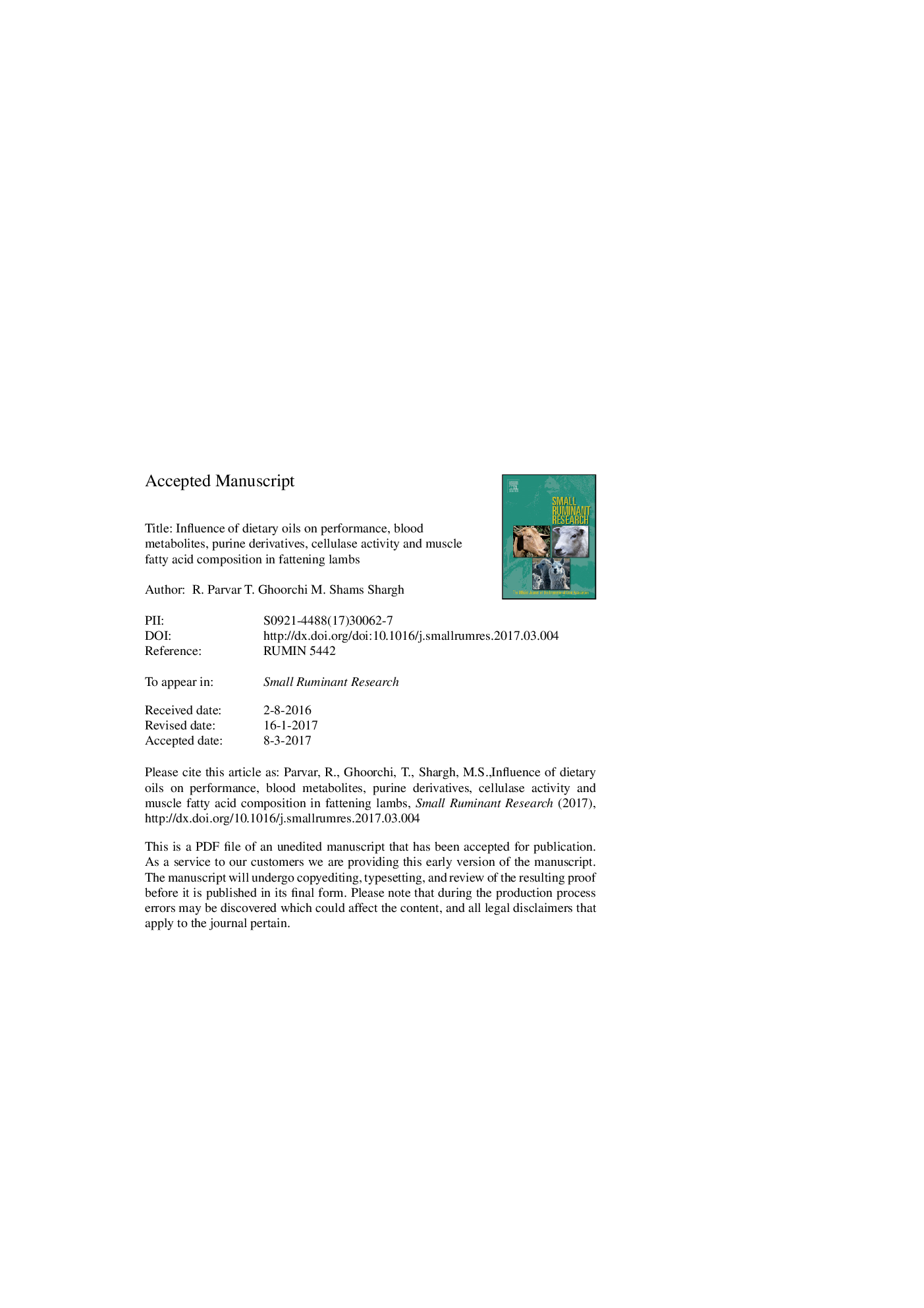| کد مقاله | کد نشریه | سال انتشار | مقاله انگلیسی | نسخه تمام متن |
|---|---|---|---|---|
| 5544165 | 1554342 | 2017 | 28 صفحه PDF | دانلود رایگان |
عنوان انگلیسی مقاله ISI
Influence of dietary oils on performance, blood metabolites, purine derivatives, cellulase activity and muscle fatty acid composition in fattening lambs
ترجمه فارسی عنوان
تأثیر روغنهای رژیم بر عملکرد، متابولیت های خون، مشتقات پورین، فعالیت سلولاز و ترکیب اسید چرب ماهیچه در بره های چاقی
دانلود مقاله + سفارش ترجمه
دانلود مقاله ISI انگلیسی
رایگان برای ایرانیان
کلمات کلیدی
نفت، کارایی، پروتئین میکروبی، فعالیت های آنزیم، اسیدهای چرب، گوشت بره،
موضوعات مرتبط
علوم زیستی و بیوفناوری
علوم کشاورزی و بیولوژیک
علوم دامی و جانورشناسی
چکیده انگلیسی
The aim of this study was to investigate the effects of canola, soybean and fish oils on performance, cellulase enzyme activity, microbial protein synthesis and the fatty acid profile of longissimus muscle in fattening lambs. Thirty-five male lambs with an initial body weight of 27.8 ± 2 kg were used in a completely randomized design for an 84-day feeding period. The experimental treatments included: (1) control diet (without oil), (2) diet with 3% fish oil, (3) diet with 3% canola oil, (4) diet with 3% soybean oil, (5) diet with 1.5% fish oil + 1.5% canola oil (FO + CO), (6) diet with 1.5% fish oil + 1.5% soybean oil (FO + SO), (7) diet with 1.5% canola oil + 1.5% soybean oil (CO + SO). No differences were found among treatment of soybean oil, canola oil, FO + CO and control treatment for Daily weight gains (DWG). However, the diets which contained fish oil, FO + SO and CO + SO had lower DWG. Oil supplementations did not affect dry matter intake, feed conversion ratio and hot carcass weight (P > 0.05). Ruminal pH and ammonia nitrogen did not differ among treatments. Oils had no effect on concentrations of serum glucose, cholesterol, triglyceride and blood urea-N concentrations (P > 0.05). No significant differences were found among treatments for purine derivatives and the microbial N (P > 0.05). The particulate material and total activity of carboxy methyl-cellulase (CMM) were negatively affected by inclusion of oils in feeds (P < 0.05). No differences were observed for the microcrystalline-cellulase activity (MCC) among treatments (P > 0.05). The particulate material had the highest enzyme activity in different fractions of CMC and MCC. The most abundant fatty acid was oleic (C18:1 cis-9), followed by palmitic (C16:0) and stearic (C18:0). The lambs fed with fish oil had the highest the C20:5n-3 and C22:5 or C22:6n-3. The concentrations of saturated fatty acids significantly reduced with different oil supplementations (P < 0.05). The oil supplementations effectively decreased n-6 to n-3 ratio in the longissimus muscle compared with the control diet (P < 0.05). In conclusion, soybean, canola and fish oils up to 3% separately or binary-blend of these oils in equal proportions (also up to 3%) can be used in diet of fattening lambs. In addition, inclusion of oils in ration improved the meat content of polyunsaturated fatty acids, especially the level of long-chain n-3 fatty acids.
ناشر
Database: Elsevier - ScienceDirect (ساینس دایرکت)
Journal: Small Ruminant Research - Volume 150, May 2017, Pages 22-29
Journal: Small Ruminant Research - Volume 150, May 2017, Pages 22-29
نویسندگان
R. Parvar, T. Ghoorchi, M. Shams Shargh,
